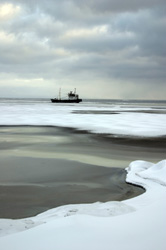Measuring the heat flux in the Barents Sea
The Barents Sea, which sits off the northern coast of Europe, is an important link between the Atlantic and Arctic Oceans. Inflow of warm Atlantic Water (AW) ensures that ports in Norway, Russia and other countries bordering the sea remain ice-free during the winter. This flow was the target of a focussed research effort led by the Institute of Marine Research (IMR) in Bergen, Norway. Moored instrumentation was used during the project, entitled ASOF-N, to measure temperature and velocity in the vicinity of the Western Barents Slope (WBS). This data was combined with hydrographical information to provide the most accurate estimates of heat flux to date. IMR calculated an average net heat flux of approximately 40 Terrawatts toward the Barents Sea, though its magnitude was found to vary significantly from year to year. The flux does not always take the form of a single, large flow; it frequently separates into several smaller branches that can be offset by return flows. The most important discovery made by IMR and its ASOF-N partners is that water temperature on the WBS is not at all correlated with the flux of AW. In fact, the flux is driven primarily by local wind conditions. Thus, it is critical to measure both temperature and velocity in order to properly assess both short-term and long-term variability. A final component of the research project entailed a modelling exercise to fill in gaps in the observation network. IMR coupled a sea ice model, which is essential for modelling a region like the Barents Sea, with a general ocean circulation model (the Regional Ocean Model System). This system was used in hindcasting mode to reproduce the heat flux from 1990 and thereafter throughout the duration of the project.







